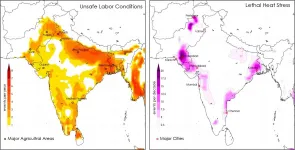(Press-News.org) WASHINGTON--Residents of South Asia already periodically experience heat waves at the current level of warming. But a new study projecting the amount of heat stress residents of the region will experience in the future finds with 2 degrees Celsius of warming, the population's exposure to heat stress will nearly triple.
Limiting warming to 1.5 degrees Celsius will likely reduce that impact by half, but deadly heat stress will become commonplace across South Asia, according to the new study in Geophysical Research Letters, AGU's journal publishing high-impact, short-format reports with immediate implications spanning all Earth and space sciences.
With almost one quarter of the world's population living in South Asia, the new study underlines the urgency of addressing climate change.
"The future looks bad for South Asia, but the worst can be avoided by containing warming to as low as possible," said Moetasim Ashfaq, a computational climate scientist at Oak Ridge National Laboratory and corresponding author of the new study. "The need for adaptation over South Asia is today, not in the future. It's not a choice anymore."
Earth has warmed by 1 degree Celsius since the start of the Industrial Revolution, according to the Intergovernmental Panel on Climate Change. On the current climate trajectory, it may reach 1.5 degrees Celsius of warming in 2040. This deadline leaves little time for South Asian countries to adapt. "Only half a degree increase from today is going to cause a widespread increase in these events," Ashfaq said.
A hot region getting hotter
People living in South Asia are especially vulnerable to deadly heat waves because the area already experiences very hot, humid summers. Much of the population live in densely populated cities without regular access to air conditioning, and about 60% perform agricultural work and can't escape the heat by staying indoors.
In the new study, the researchers used climate simulations and projections of future population growth to estimate the number of people who will experience dangerous levels of heat stress in South Asia at warming levels of 1.5 and 2 degrees Celsius. They estimated the wet bulb temperature residents will experience, which is similar to the heat index, as it takes into account humidity as well as temperature. A wet bulb temperature of 32 degrees Celsius (89.6 degrees Fahrenheit) is considered to be the point when labor becomes unsafe, and 35 degrees Celsius (95 degrees Fahrenheit) is the limit to human survivability - when the body can no longer cool itself.
Their analysis suggests at 2 degrees of warming, the population's exposure to unsafe labor temperatures will rise more than two-fold, and exposure to lethal temperatures rises 2.7 times, as compared to recent years.
Curbing warming to 1.5 degrees Celsius will likely cut that exposure in half, but large numbers of people across South Asia will still experience extreme temperatures. An increase in heat events that create unsafe labor conditions are likely to occur in major crop producing regions in India, such as West Bengal and Uttar Pradesh, and in Pakistan in Punjab and Sindh. Coastal regions and urban centers such as Karachi, Kolkata, Mumbai, Hyderabad and Peshawar are also likely to be heavily affected, according to the study.
"Even at 1.5 degrees, South Asia will have serious consequences in terms of heat stress," Ashfaq said. "That's why there is a need to radically alter the current trajectory of greenhouse gas emissions."
The results differ from a similar study conducted in 2017, which predicted that heat waves of lethal temperatures will occur in South Asia toward the end of the 21st century. The researchers suspect the earlier study is too conservative, as deadly heat waves have already hit the region in the past. In 2015, large parts of Pakistan and India experienced the fifth deadliest heat wave in the recorded history, which caused about 3,500 heat-related deaths.
"A policy framework is very much needed to fight against heat stress and heat wave-related problems," said T.V. Lakshmi Kumar, an atmospheric scientist at India's SRM Institute of Science and Technology who was not involved in the work. "India has already committed to reduce emissions to combat climate change issues."
The study was supported by National Climate?Computing Research Center, which is located within ORNL's National Center for Computational Sciences and supported under a Strategic Partnership Project between Department of Energy and National Oceanic and Atmospheric Administration.
INFORMATION:
AGU (http://www.agu.org) supports 130,000 enthusiasts to experts worldwide in Earth and space sciences. Through broad and inclusive partnerships, we advance discovery and solution science that accelerate knowledge and create solutions that are ethical, unbiased and respectful of communities and their values. Our programs include serving as a scholarly publisher, convening virtual and in-person events and providing career support. We live our values in everything we do, such as our net zero energy renovated building in Washington, D.C. and our Ethics and Equity Center, which fosters a diverse and inclusive geoscience community to ensure responsible conduct.??
Notes for Journalists
This research study will be freely available for 30 days. Download a PDF copy of the paper here. Neither the paper nor this press release is under embargo.
Paper title:
"Deadly heat stress to become commonplace across South Asia already at 1.5°C of global warming"
Authors:
Moetasim Ashfaq, Oak Ridge National Laboratory, Oak Ridge, Tennessee
Fahad Saeed, Climate Analytics, Berlin, Germany
Carl-Friedrich Schleussner, Climate Analytics, Berlin, Germany
An old technique flexes its muscles
Sarcomeres are small repeating subunits of myofibrils, the long cylinders that bundle together to make the muscle fibres. Inside the sarcomeres, filaments of the proteins myosin and actin interact to generate muscle contraction and relaxation. So far, traditional experimental approaches to investigate the structure and function of muscle tissue were performed on reconstructed protein complexes or suffered from low resolution. "Electron cryo-tomography, instead, allows us to obtain detailed and artefact-free 3D images of the frozen muscle", says Raunser.
Cryo-ET was for a long time an established yet niche methodology. But recent technical advances in electron cryo-microscopy (cryo-EM) as well as the new development of ...
In the heart of black cherry's native range, including a part of the Allegheny Hardwoods that bills itself as the "Black Cherry Capital of the World," the tree's regeneration, growth and survival have all been declining for more than a decade. In a new analysis, a team of USDA Forest Service and University of Missouri scientists identify likely factors behind the tree's decline and, more significantly, conclude that black cherry may be the tip of the iceberg in terms of change in eastern deciduous forests.
Scientists used a combination of synthesis of existing research and new analyses to examine the leading hypotheses for black cherry's regeneration failure. They conclude that the two factors that are ...
Family-centered prevention programs that foster protective caregiving can buffer the negative effects of racial discrimination on young Black people, according to a study published by University of Georgia researchers.
Research shows that Black youth exposed to various levels of racial discrimination--including slurs, threats and false accusations--are at a high risk for poor mental health outcomes such as hopelessness, conduct problems, drug use and depression. After participating in family-oriented programs, high school-age adolescents who encountered high levels of racial discrimination and received supportive caregiving evinced fewer increases in conduct problems and depression/anxiety symptoms two years later.
"This research shows that ...
The high temperatures and pressures of the Earth's mantle forge carbon-rich minerals known as carbonates into diamond. But less is known about the fate of carbonates that travel even deeper underground -- depths from which no sample has ever been recovered.
Now, Michigan State University's Susannah Dorfman and her team are unearthing an answer with lab tools that mimic these extreme conditions.
"What we were interested in is, when is carbon not diamond?" added Dorfman.
In a paper recently published in Nature Communications, scientists in Dorfman's Experimental ...
Researchers at the Paul Scherrer Institute PSI have studied for the first time how chemical reactions in clouds can influence the global climate. They found that isoprene, the dominant non-methane organic compound emitted into the atmosphere, can strongly contribute to the formation of organic aerosols in clouds. They published their results today in the journal Science Advances.
Aerosols, a mixture of solid or liquid particles suspended in the air, play an important role in Earth's climate. Aerosols originate either from natural or human sources. They influence Earth's radiation balance by interacting with sunlight and forming clouds. However, their effect remains the single most significant uncertainty ...
CHICAGO -- Immunotherapy, which recruits the body's own immune system to attack cancer, has given many cancer patients a new avenue to treat the disease.
But many cancer immunotherapy treatments can be expensive, have devastating side effects, and only work in a fraction of patients.
Researchers at the Pritzker School of Molecular Engineering at the University of Chicago have developed a new therapeutic vaccine that uses a patient's own tumor cells to train their immune system to find and kill cancer.
The vaccine, which is injected into the skin just like a traditional vaccine, stopped ...
Addressing uncertainties about where large earthquakes are most likely to occur along the southern San Andreas fault, which splits into multiple strands east of Los Angeles, a new study identifies a strand that has largely flown under the radar of public concern as the region's greatest earthquake threat. The study determines that the Mission Creek strand, which passes through major water and power infrastructure for the greater Los Angeles region, may account for almost the entire slip rate of this portion of the fault, suggesting it may actually be the primary Pacific-North American plate boundary fault at this latitude. The San Andreas fault threatens large future earthquakes, since its southernmost section has not ruptured in almost 300 years ...
A 12-centimetre-thick sample of a deposit from a cave in the northeast of Greenland offers unique insights into the High Arctic's climate more than 500,000 years ago. The geologist and cave scientist Prof. Gina Moseley collected it during an exploratory expedition in 2015 for her palaeoclimatic research in one of the most sensitive areas of the world to climate change. The cave is located at 80° North 35 km from the coast and 60 km from the Greenland Ice Sheet margin. It was part of the Greenland Caves Project, funded by 59 different sponsors including the National Geographic Society. Moseley and her team are interested in the climate and environmental history captured by the unique cave deposit. "Mineral deposits formed ...
A study of 49 patients reveals that toxins from the bacterial pathogen Staphylococcus aureus can destroy the body's blood-clotting platelets, raising the risk of death during bacterial blood infections. Further experiments in mice also showed that the approved drugs ticagrelor and oseltamivir protected platelets and helped treat infections, suggesting these compounds could be repurposed into badly needed therapies for blood infections. Bacterial blood infections have mortality rates as high as 20% to 30% even with supportive care, and these rates have remained high for decades. Blood infections can also cause complications such as sepsis and endocarditis, and the rise of multidrug resistance has only compounded what was already a serious ...
Immunotherapy, which recruits the body's own immune system to attack cancer, has given many cancer patients a new avenue to treat the disease.
But many cancer immunotherapy treatments can be expensive, have devastating side effects, and only work in a fraction of patients.
Researchers at the Pritzker School of Molecular Engineering at the University of Chicago have developed a new therapeutic vaccine that uses a patient's own tumor cells to train their immune system to find and kill cancer.
The vaccine, which is injected into the skin just like a traditional vaccine, stopped melanoma tumor growth in mouse models. It even worked long-term, destroying new tumors long after the therapy was given.
The results were published ...



